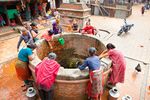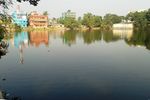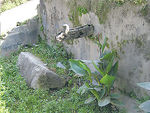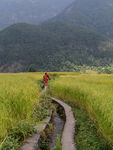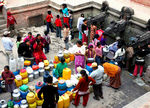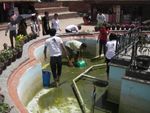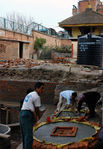Traditional water system, Nepal
---> back to group page working group J
Traditional Water System in Patan, Nepal
| Name | Traditional water system | |
| Country | Nepal | |
| City | Patan | |
| Authors | Neha Shrestha | |
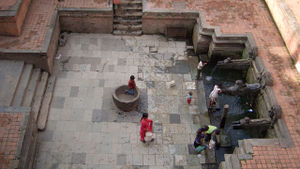
| ||
|
| ||
Rationale: Why is this case interesting?
Please explain in short why this site has green infrastructure potential and what makes it special (150 words approx)
Patan (Lalitpur) metropolitan city is one of the largest cities in Nepal with the area of 15.43 square kilometer. Due to its growing population Patan is facing severe water scarcity. Besides from investigating the possibilities to increase the municipal supply from alternative sources, the scarcity of water has made them to re-think, conserve and revive the traditional water system which was built with knowledge, intelligence and skills. These water system were established in such a way that they could serve the population both in quality and quantity throughout the year. It uses special techniques locating the water sources and bringing it to the site. On the other hand people are forgetting their traditional sustainable system and adopting modern mismatch system because of this negligence the traditional water system are drying up or reduced. So it is very important to conserve the water system in terms to protect our indigenous traditional water system and providing the local the alternative source of water for their daily use.
Author's perspective
what is your professional/educational background and your relation to the site?
I am studying landscape architecture with Architecture as my professional background. I have practiced as architect in my home land but have not yet practiced as landscape architecture in a professional field. This site concerns me as it belongs to my country and has been facing similar problem relating my home town. The town is implementing some projects to conserve traditional water system and to diminish the water problem which can also be a good example for my home area.
Landscape and/or urban context of your case
- Biogeography, cultural features, overall character, history and dynamics
History and dynamics
The construction of water systems can be linked to early settlements of Kirats who used ponds and springs in the tar lands and hill slopes. Later Lichchhavies connected the ponds and spouts to discharge water from stone spouts. 58 water spouts were constructed in Patan and its surroundings of which 4 are dry and 7 do not exist. Most of the spouts are located in the core of historic settlements. The oldest spout found in Patan is at Mangal Bazaar known as Manga hiti built in 570 AD. Massive water works were established during the period of Lichchhavies and extended during Malla rule. The canals and ponds were improved by Ranas as well. Several drains were covered by Ranas with brick arch canals. The whole water system was not established during the time of single king but was successively added and improved during the time of Lichchhavies and their successor Mallas.
Biogeography
The city of Patan is located on the northern sloppy terrain of Phulchwoki, the southern hills of Kathmandu valley. One component of water system known as pukhu (pond) which is used to store water for this water system is very important in terms of ecosystem. The ponds are has rich diversity of flora and fauna especially the Lotus. The pond is habitat for ducks and fishes. On the other hand it also supports agriculture and supplies water to human life.
Overall character
The traditional water system consists of 5 major components. • The intake; • The conveyance system – surface or sub- surface water flow channels; • Water storing or recharging bodies – pukhus (ponds); • Water conduits – the spouts and wells; • The drainage system. The water system especially (stone spouts, wells, ponds) acts as domestic house hold purpose to supply water for the people. It is used for people for drinking as well as washing purpose. It also serves for irrigation purpose.
Cultural features
During ancient period the people used to worship source of water and managed them according to the situation. The cultural linkage to traditional water system still exists in Lalitpur. The stone spouts one of the traditional water system not only resembles the engineered water conduits but also lavishly designed religious master piece of architecture. The water spouts consists of beautifully carved crocodile head (crocodile or makara in Sanskrit is the vehicle of Ganga, the Goddess of water) which is considered as holy water animal with water pouring out of the mouth and few idols of water related gods, creatures, properly located with their religious beliefs and functions. The water from these water spouts is considered as pure and holy and is used for daily religious activities, rituals for temples and shrines. There is also a strong belief that water from certain spouts has medicinal qualities so some baidyas (Ayurvedic homeopathic medicinal practitioners) use water for treating diseases. People believe Cleaning water spouts makes god happy and every ever year during various occasions people clean and maintain the water spout complex.
- Illustrations: maps; sketches; short descriptive analyses
The spatial location, the functionality, the religious use and cultural hierarchy, are some of the important aspects of stone spouts in Patan. The water spouts and dug wells are primary sources of water for domestic purpose. The water spout complex is constructed in a large pit on the ground which makes the sources of water from local aquifer or natural sub-surface flow or manmade channel to transmit from the convenient collection. The complex consists of one or more stone spouts based on water discharge and number of users. The water in the water spouts were provided by bifurcating the main source into several outlets or different aquifer sources to minimize the risk of drying the water spout. These are fed by rainwater collected in aquifers (layers of permeable rock, sand or gravel through which ground water flows). These aquifers should be special formation of geography on the slopes which made possible to store water in the sand reservoir.
The ponds are built as reservoirs nearby to recharge these aquifers to maintain the flow of water even during the dry seasons. These ponds in turn are supplied water from rajkulos, the canal system built to provide water for everyday use, irrigate farmlands and fill the ponds. Before supplying to water spout the water were filtrate using sands of various grading, gravel and even charcoal. Various designs were adopted for the sand filter for the treatment of water. The filtered water was provided in a spout or in a distribution vessel to distribute water. The distribution vessel may be provided with holes at different levels so that the lowest connection provides adequate flow. The joints are sealed with impermeable clay lining. The stone spouts are centrally located on one or more side walls hanging about a meter so that the water can be fetched directly in water vessel.
Drainage of stone spouts is another important part of water system. The base platform for the complex is normally paved in stone with side drain. The drain outlets are provided to discharge the water out of the settlement. In some cases they are collected in the ponds for different purposes. The outlet is normally taken out of settlement for irrigation purpose.
The dug well collects the water from the aquifer. Unlike water spouts the dug wells are not directly linked with ponds and water canal however the destruction of ponds and water canal affects in infiltration of water in the wells.
- Illustrations
Analytical drawings
- Please use analytical drawing for visualising the conflicts/potentials of your site
The traditional has potentiality in respect to multi functionality and sustainability. This system is used for different purpose and because of its natural and skilled construction it is more sustainable. But due to absence of ownership the traditional water supply system is falling down gradually and slowly both in local and city level. Also the lands which were kept by the state for ecological and historical purpose are seized by the authoritative people in the government or brought in use with other purposes. Many of these lands have been encroached by community institutions like schools, clubs, neighborhood organizations etc for extra ecological purposes. The pond and the peripheries of the pond are being encroached by community, public buildings, bus parks etc. the leakage of the sewage networks are causing eutrification damaging the pond ecosystem with waste of excessive growth of vegetation.
The water spouts provide water for all households living in the locality and nearby areas. The use of this water system was reduced when Nepal Water Supply Corporation (NWSC) started to supply water from private tap system and thus the heritage site slowly turned into a dumping site. But due to increase in population the NSWC started to supply water intermittently and even failed to supply water to this area in according to schedule. So the people are forced to depend on the traditional water sources.
Due to different construction activities the supply of water to the water spouts are being disturbed. The construction of foundation for large buildings, construction of drainage and pipelines crossing the flow of path of aquifers are the major causes of flow reduction in some water spouts causing obstruction to natural flow, infiltration of the aquifer water into the drain and exfiltration of the sewage into the water spouts.
However it was difficult to fetch water from the existing spout due to increase in population on one hand and the flow of water had decreased from the spout on the other. People need to spend more than 5-6 hours a day to fetch the water. People from neighboring areas also depend on same spout as they also failed to get water from NWSC (Nepal Water Supply Corporation). This causes disputes between the different communities during water collection and in addition most of the people are taking bath and washing clothes in the spout which caused problem in the spout in terms of cleanliness. Elderly people show their disagreement to use the water from same filthy water spout as they need to follow their daily ritual with pure clean water.
- Analytical Drawings
Green Infrastructure benefits for this site
Look again at the multiple benefits of green infrastructure - what could be achieved in your site and which are most relevant?
Traditional water system serving water to the urban population of Patan is the time proven traditional technology and management system that have played important role in addressing water problem in urban centers. Revitalization of traditional water sources brings many benefits. This not only helped in preservation of cultural heritage of the area and supplying water to the local but also can promote hygiene practices implementing cleanliness rules in and area around the site which was once used as dumping spaces. For migrants and poor renters the water spout is major source of water for their daily uses.
In general the system is designed in such a way that clogging of drainage and the breaking of supply channels do not hamper the use of water in other spouts as these elements are very local in nature in terms of scale of work and scale of space.
The indicators for sustainable water system in terms of effectiveness and sustainability are encouraging. The financial indicator indicates that the user committee is cost effective in the performance and maintenance.
Potential for multifunctionality
Green infrastructure has typically multiple functions. What could be achieved for your site in this respect?
Inspite of supplying water for domestic purpose these traditional systems has multiple functions. Revitalizing the system helps in preservation of history and restores the functions of various elements of ancient water supply systems to their original form. Restoring the supply canals one of the part of this system not only fill the ponds which is a significant part of this traditional supply network but also serves in irrigation to additional areas of fertile land, increasing crop yields and cropping intensity. The pond is also potential for the protection of biodiversity.
The water from the drain of the water spout is allowed to flow for the subsurface to charge for downstream which is a unique example of water management system, a basic code of sustainability, i.e. reuse. In some cases the water are collected in a pond for other functions like duck farming, agriculture, washing etc. Whereas the abundant and permanent pond contributes to recharge aquifers, stone spouts wells and other small ponds. The water spout complex not only contributes in supplying water for the domestic purpose but also in case of cultural purpose for daily rituals. The tread on side wall of complex brings stability for the peripheral wall and also provides space for the locals for having sun bathing and drying clothes as a social purpose. Therefore, serving the population is a key to the sustainability of the system.
Projective drawings
- How would you like this case to change in the near future? (in 1-2 years)
There has been growing demands for the water supply from the households. As the piped water system cannot supply the full volume of water demand, traditional water sources such as stone spouts and wells are the potential, small scale alternative sources of water supply. In this case I would like to see the change in cases from the restoration of water spouts. The stone water spout can be preserved and restored to function as historical water sources. The restoration program must be carried out with the knowledge of hydrological cycle. These sources can help to meet the demand of water in local community. To save and increase the supply the demand, the water can be stored from the water spouts and excess water can be redistribute to desired areas a needed. The problem of dispute and waiting in the water spout can be diminished by distributing the water using pipeline managing a supply schedule for particular houses. For this case the financial aid as well as participation from the local communities and authorities is needed.
- And how could it look like in 10-15 years?
If the conservation and restoration of these traditional water system is not done. There will be water pressure in the localities from local to national level. Social conflicts, sanitation as well as sanitation problem can arise in the localities.
The operation should be done with the relatively permeable aquifers as underground reservoirs. There should be a combination of well designed and creative approaches to recharge involving, like seepage through existing irrigation channels or the construction of infiltration galleries. The system can be adopted in terms of hydrological cycle. There should be an establishment of pond network in the foot hills surrounding the area. As agriculture is still a major occupation of some areas in the place the encouragement of recharge can be done through existing irrigation and agricultural systems. The careful design with the objective of encouraging additional recharge and drawing groundwater could substantially increase supply.
The maintenance of water system including water conduits/ water system has always been great challenge due to unclear ownership and lack of fund. So the responsibility for the preservation should be given to authorities from local to the governmental level.
- Projective Drawings
Summary and conclusion
The fascinating water works of Patan are admirable works of previous centuries still existing and serving today but the technical knowledge and management skills are not followed which is a loss of future generation. From structural to mechanical perspective such as location, continuous potable water supply, recharge system of ground water, ponds and aquifers, material and technology of water conduits, effective drainage system, reuse and purification of water in different steps is a complete example of great sustainable engineering principles which can be seen in the traditional system. When one observes the stone spouts it gives the picture of religiously designed masterpiece of architecture with engineering principles. Therefore, both from social, cultural, religious and archaeological, physical or sustainable viewpoints these stone spouts are both the lifeline and ornament of these historic towns.
Image Gallery
Please add further images/photos here
- Image Gallery
- Yourimage.jpg
your image text
- Yourimage.jpg
your image text
- Yourimage.jpg
your image text
- Yourimage.jpg
your image text
- Yourimage.jpg
your image text
- Yourimage.jpg
your image text
References
http://tunza.eco-generation.org/worldReportView.jsp?viewID=3756
http://www.unep.or.jp/ietc/publications/techpublications/techpub-8e/tradition.asp
http://ecs.com.np/features/kathmandu-valley-and-its-historical-ponds
http://www.academia.edu/9456871/Dhungedharas_of_Kathmandu_Valley_
http://www.buet.ac.bd/itn/cwp/documents/casestudies/Case%20Study%20N-05.pdf
http://www.ngoforum.net/index.php?option=com_docman&task=doc_view&gid=4
A. Dixit and M. Upadhya, "Augmenting Groundwater in Kathmandu valley: Challenges and possibilities", Nepal Water Conservation Foundation, (2005)
"Water movement in Patan", United Nations Human Settlement Programme, (2008)
About categories: You can add more categories with this tag: "", add your categories


